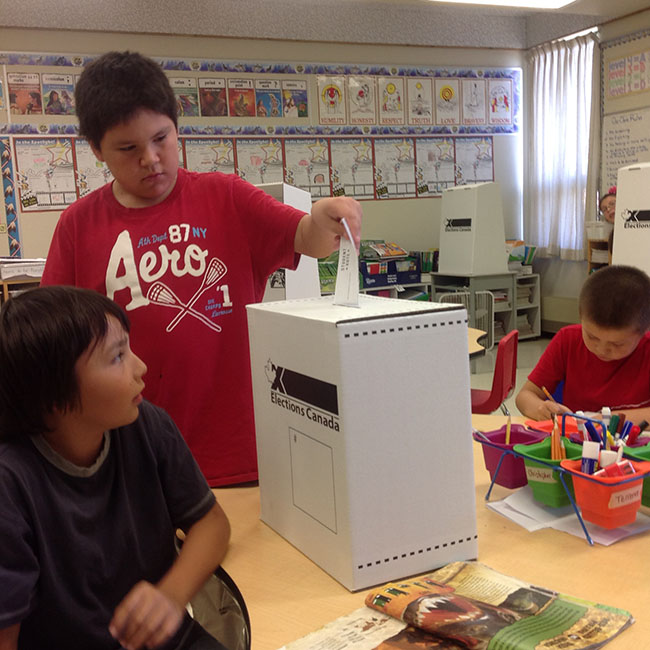Elementary students cast vote in federal election

By Colleen Toulouse
SAGAMOK ANISHINAWBEK – Biidaaban Kinoomaagegamik saw 63 students in Grades 4 to 8 cast their first ballots in a parallel federal election through the Student Vote program during National Vote Week (October 13 to 16). Students also held assigned positions such as poll clerks, scrutineers and deputy returning officers to simulate the electoral process.
Mrs. Pam Solomon, Grade 4 Teacher found out about Student Vote through social media and felt this was a way to give students a taste of why we vote and what it’s like to vote for the candidates in their federal electoral district, Algoma-Manitoulin-Kapuskasing.
Never in federal election history has there been a major push to have First Nations people vote. Perhaps teaching students at a young age about government and the electoral process may change the future of First Nations participation in federal elections. “Students that participate in the program, this may increase chances that they will vote when they are of age and it also makes them more aware of what is happening in their country and they will show an interest,” said Solomon.
Student Vote, offered through CIVIX, a national charity is working towards building the skills and habits of citizenship among young Canadians. The federal election program is being delivered in partnership with Elections Canada, Canada’s national electoral agency. Over 6,000 registered schools participated and received educational resources, posters, riding maps, ballots and ballot boxes free of charge. Biidaaban students were among the 850,000 students to participate.
Baily Toulouse, Grade 5 student enjoyed Student Vote. He was correct when he predicted Carol Hughes, NDP Candidate to win the 2015 Canadian federal election for his riding. “Hughes is good at representing our area,” he said. “When we vote, we are voting the person to represent our area and Canada. We are voting for our government which helps the economy and the country.”
In fact, Carol Hughes of the NDP received the highest votes among Biidaaban students with a vote count of 24 (38.10%). Heather Wilson, Liberal Party of Canada came second with 19 votes(30.16%), Calvin John Orok, Green Party of Canada received 16 (25.40%), and finally André Robichaud, Conservative Party of Canada received four votes (6.35%). Results of Student Vote are shared on the CIVIX website, as well a full breakdown of all participating schools is provided.
According to Elections Canada’s National Youth Survey Report released in November 2011, “the most important motivational barriers to voting were lack of political interest and knowledge, a belief that all political parties were the same and that no party spoke to issues relevant to youth, and a lower sense that voting was a civic duty.”
Solomon said, “I didn’t hear too much talk before but students showed an interest after our election and I could hear them talking about it in the hallways and asking questions in class.”
CIVIX believe that practicing the habits of informed and engaged citizenship at an early age, students will be more inclined and to participate in our democracy when they graduate high school.
“I am going to vote when I get older. I learned about our elections by reading and doing the vote (in our school), said Bailey.


